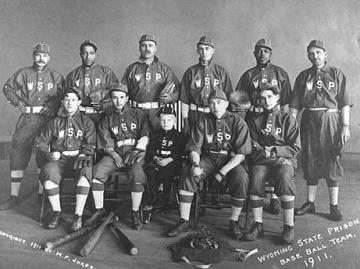Chapter Three
Death Row
Death Row
We leave the tiered cell block buildings of the Wyoming State Penitentiary in Rawlins and walk into the afternoon Wyoming sunshine. Its warmth is appreciated after the chill of the cellblocks.
Before us is “the yard.” This is where prisoners were allowed to enjoy the outdoors for a brief time.
 |
| From: https://www.wyohistory.org/sites/default/files/images/stateprisonbaseballteam.img_assist_custom-360x269.jpg |
The team was started by prisoner George Henry Sabin, who, along with several others, were convicted of murder when they, on behalf of cattle ranchers, ambushed the camp of sheepherders and killed three men.
That first rate baseball team came to an end when Seng came to the end of his time and was hanged for his crime.
Visible in the yard is the foundation of where a broom factory once existed, until prisoners burned it down during a 1917 riot in which the convicts protested deteriorating conditions in the penitentiary.
Thereafter, shirt manufacturing became the prison industry, which enabled one prisoner to escape by hiding in a crate of shirts. During World War II, the prison had a woolen mill and made blankets of such fine quality that it received a contract from the Navy for blankets for the duration of the war.
Our guide leads us to a door that looks like a shed door, and opens it. Before us is a Rube Goldberg contraption with ropes and buckets and 2x4s that look like they’re meant to collapse in odd directions.
 |
| Pretty sure this is a reconstruction, and not the original |

On a November morning in 1903, in Cheyenne, Wyoming, desperado Tom Horn stood on a small trapdoor above this contraption called the “Julian Gallows.” It was invented by James Julian to provide a “more humane” method of carrying out executions, one in which no person was required to trip the trap door. Horn was the first to try out the gallows.
Horn’s weight on the trap door pushed down on a support post that depressed a spring which in turn opened a water valve. Flowing water gradually filled a can balanced on a support beam. Once full, the can toppled from the beam, which then knocked aside the support post, opening the trap and dropping the prisoner into eternity.
Denver journalist John Charles Thompson, who had a seat at the gallows, wrote that “the sinister sound of running water” persisted for 31 seconds before Horn fell.
“To the straining ears of the listeners,” Thompson wrote, “that little sound had the magnitude of that of a rushing torrent.”
Julian’s rig was supposed to offer a quick snap of the neck, the benchmark of a humane hanging. It didn't work. Horn dangled for 17 minutes before his pulse ceased.
We go upstairs to the room itself, passing by the death row cells with a warning from the guide not to walk in front of the cells.
The trap door has been sealed shut. When a condemned man stood on it with a noose around his neck, he could catch his last glimpse of the world outside this prison through a small window.
 |
| The trap door, now sealed. |
In the next room is the gas chamber. Its door swings open and we are invited in. It’s quite small, with just enough room to walk around the chair in the center.
As we turn around to leave, the guide explains why we are not allowed to walk in front of the death row cells. Some years ago, a prisoner was able to escape his cell at night and let others loose. They began working on an escape tunnel.
When the escape plans were discovered, prison authorities could never find out what the men did with the dirt from their tunnel.
Not until a section of the ceiling caved in, that it. And once you know the story, you can see how the ceiling sections are bowed with the weight of dirt still up there, the bygone hopes of freedom of incarcerated men likely buried in it.











Poor Tom Horn. He was hired by ranchers to dispose of cattle rustlers, which was a crime punishable by death. It is still thought that he was set up and supposedly killed a young boy. He totally denied it, but that is what got him hung. The tour of the prison was very interesting.
ReplyDelete